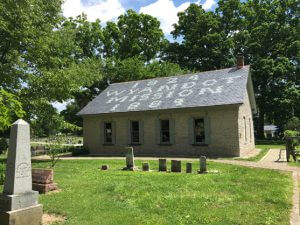Founder of the first permanent Methodist Episcopal mission among the Native Americans

Born in Virginia of free parentage, Stewart was a Baptist of mixed European and African descent. After he was robbed on his way to Ohio, he attempted to drink himself to death. Suffering agony of soul, he was delivered from depression by joining the Methodists during a camp meeting.
He became ill from resisting a call to preach. Recovery commenced after he agreed to obey God. He heard the voice of a woman and a man calling him to preach to the Native Americans, and he set off in a northwesterly direction.
He sang and preached to the Delawares on the way to the Wyandott Native Americans. Reaching the Wyandotts, he was befriended by a government agent who directed him to Jonathan Pointer, an African American who had been captured by the Native Americans and was fluent in Wyandott.
With Pointer as interpreter, Stewart began to sing and to preach to them in 1816. Despite opposition, he warned the Wyandotts to “flee the wrath to come.” His singing and preaching resulted in the conversion of the chiefs, leading women, and others.
Rival missionaries appeared and accused him of exercising ministerial functions without a license. Supported by converts, Stewart requested recognition by the Methodist Episcopal Church and was accordingly licensed in 1819. The church supported his mission work financially and by appointing missionaries to continue it. Stewart’s example helped to inspire the formation of the Methodist Missionary Society in 1820.
By Dana L. Robert.
This article is reprinted from Biographical Dictionary of Christian Missions, Macmillan Reference USA, copyright 1998 Gerald H. Anderson, by permission of Macmillan Reference USA, New York, NY. All rights reserved. It is taken, with permission, from the History of Missiology: http://www.bu.edu/missiology/missionary-biography/r-s/stewart-john-1786-1823/
Bibliography
Digital Texts
Love, N. B. C. John Stewart, Missionary to the Wyandots (1900) as reprinted in Ohio History by Ohio Historical Society in 1908.
Excerpts from Thelma Marsh’s book, Moccasin Trails to the Cross: A History of the Mission to the Wyandott Indians on the Sandusky Plains, with an extended biographical portrait of John Stewart (Excerpt one: “First Missionary”).
Excerpt two: “Testing and Trials”
Excerpt three: “John’s Letter to the Wyandott”
Excerpt four: “Stewart Returns to the Wyandotts”
Mitchell, Joseph. The Missionary Pioneer, or a Brief Memoir of the Life, Labours, and Death of John Stewart (Man of Colour), Founder, under God, of the Mission among the Wyandotts at Upper Sandusky, Ohio. New York: Printed by J.C. Totten, 1827.
Secondary
Finley, James B. Life Among the Indians; Or, Personal Reminiscences and Historical Incidents Illustrative of Indian Life and Character. Printed at the Methodist book concern in Cincinnati for the author, 1857. Reprinted Freeport, NY: Books for Libraries Press, 1971.
Love, N. B. C. John Stewart, Missionary to the Wyandots. New York: Missionary Society of the Methodist Episcopal Church, 1900.
Marsh, Thelma R., Moccasin Trails to the Cross: A History of the Mission to the Wyandott Indians on the Sandusky Plains. Upper Sandusky, OH: John Stewart United Methodist Church, 1974.
Mitchell, Joseph. The Missionary Pioneer, or a Brief Memoir of the Life, Labours, and Death of John Stewart (Man of Colour), Founder, under God, of the Mission among the Wyandotts at Upper Sandusky, Ohio. New York: Printed by J.C. Totten, 1827.
Links
Wyandott Indian Mission in Upper Sandusky, Ohio is a Heritage Landmark of The United Methodist Church. More information can be found at: http://www.gcah.org/research/travelers-guide/wyandott-indian-mission




